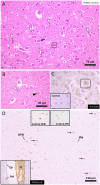In-frame deletion in canine PITRM1 is associated with a severe early-onset epilepsy, mitochondrial dysfunction and neurodegeneration
- PMID: 33835239
- PMCID: PMC8519929
- DOI: 10.1007/s00439-021-02279-y
In-frame deletion in canine PITRM1 is associated with a severe early-onset epilepsy, mitochondrial dysfunction and neurodegeneration
Abstract
We investigated the clinical, genetic, and pathological characteristics of a previously unknown severe juvenile brain disorder in several litters of Parson Russel Terriers. The disease started with epileptic seizures at 6-12 weeks of age and progressed rapidly to status epilepticus and death or euthanasia. Histopathological changes at autopsy were restricted to the brain. There was severe acute neuronal degeneration and necrosis diffusely affecting the grey matter throughout the brain with extensive intraneuronal mitochondrial crowding and accumulation of amyloid-β (Aβ). Combined homozygosity mapping and genome sequencing revealed an in-frame 6-bp deletion in the nuclear-encoded pitrilysin metallopeptidase 1 (PITRM1) encoding for a mitochondrial protease involved in mitochondrial targeting sequence processing and degradation. The 6-bp deletion results in the loss of two amino acid residues in the N-terminal part of PITRM1, potentially affecting protein folding and function. Assessment of the mitochondrial function in the affected brain tissue showed a significant deficiency in respiratory chain function. The functional consequences of the mutation were modeled in yeast and showed impaired growth in permissive conditions and an impaired respiration capacity. Loss-of-function variants in human PITRM1 result in a childhood-onset progressive amyloidotic neurological syndrome characterized by spinocerebellar ataxia with behavioral, psychiatric and cognitive abnormalities. Homozygous Pitrm1-knockout mice are embryonic lethal, while heterozygotes show a progressive, neurodegenerative phenotype characterized by impairment in motor coordination and Aβ deposits. Our study describes a novel early-onset PITRM1-related neurodegenerative canine brain disorder with mitochondrial dysfunction, Aβ accumulation, and lethal epilepsy. The findings highlight the essential role of PITRM1 in neuronal survival and strengthen the connection between mitochondrial dysfunction and neurodegeneration.
© 2021. The Author(s).
Conflict of interest statement
HL is a paid consultant to Genoscoper Laboratories Ltd providing genetic tests for dogs. JD is an employee of Genoscoper Laboratories Ltd.
Figures









Similar articles
-
Defective PITRM1 mitochondrial peptidase is associated with Aβ amyloidotic neurodegeneration.EMBO Mol Med. 2016 Mar 1;8(3):176-90. doi: 10.15252/emmm.201505894. EMBO Mol Med. 2016. PMID: 26697887 Free PMC article.
-
Gain of PITRM1 peptidase in cortical neurons affords protection of mitochondrial and synaptic function in an advanced age mouse model of Alzheimer's disease.Aging Cell. 2021 May;20(5):e13368. doi: 10.1111/acel.13368. Epub 2021 May 5. Aging Cell. 2021. PMID: 33951271 Free PMC article.
-
Mitochondrial PITRM1 peptidase loss-of-function in childhood cerebellar atrophy.J Med Genet. 2018 Sep;55(9):599-606. doi: 10.1136/jmedgenet-2018-105330. Epub 2018 May 15. J Med Genet. 2018. PMID: 29764912
-
Role of PITRM1 in Mitochondrial Dysfunction and Neurodegeneration.Biomedicines. 2021 Jul 17;9(7):833. doi: 10.3390/biomedicines9070833. Biomedicines. 2021. PMID: 34356897 Free PMC article. Review.
-
Dynamin-related protein 1: A critical protein in the pathogenesis of neural system dysfunctions and neurodegenerative diseases.J Cell Physiol. 2019 Jul;234(7):10032-10046. doi: 10.1002/jcp.27866. Epub 2018 Dec 4. J Cell Physiol. 2019. PMID: 30515821 Review.
Cited by
-
Identification of a Novel Idiopathic Epilepsy Risk Locus and a Variant in the CCDC85A Gene in the Dutch Partridge Dog.Animals (Basel). 2023 Feb 23;13(5):810. doi: 10.3390/ani13050810. Animals (Basel). 2023. PMID: 36899667 Free PMC article.
-
Mitochondrial dysfunction in epilepsy: mechanistic insights and clinical strategies.Mol Biol Rep. 2025 May 20;52(1):470. doi: 10.1007/s11033-025-10577-1. Mol Biol Rep. 2025. PMID: 40392243 Review.
-
An Overview of Canine Inherited Neurological Disorders with Known Causal Variants.Animals (Basel). 2023 Nov 18;13(22):3568. doi: 10.3390/ani13223568. Animals (Basel). 2023. PMID: 38003185 Free PMC article. Review.
-
Protein profiling and assessment of amyloid beta levels in plasma in canine refractory epilepsy.Front Vet Sci. 2023 Dec 21;10:1258244. doi: 10.3389/fvets.2023.1258244. eCollection 2023. Front Vet Sci. 2023. PMID: 38192726 Free PMC article.
-
Dogs as a Natural Animal Model of Epilepsy.Front Vet Sci. 2022 Jun 22;9:928009. doi: 10.3389/fvets.2022.928009. eCollection 2022. Front Vet Sci. 2022. PMID: 35812852 Free PMC article. Review.
References
-
- Berendt M, Farquhar RG, Mandigers PJ, Pakozdy A, Bhatti SF, De Risio L, Fischer A, Long S, Matiasek K, Munana K, Patterson EE, Penderis J, Platt S, Podell M, Potschka H, Pumarola MB, Rusbridge C, Stein VM, Tipold A, Volk HA. International veterinary epilepsy task force consensus report on epilepsy definition, classification and terminology in companion animals. BMC Vet Res. 2015;11:182–192. doi: 10.1186/s12917-015-0461-2. - DOI - PMC - PubMed
-
- Broeckx BJ, Hitte C, Coopman F, Verhoeven GE, De Keulenaer S, De Meester E, Derrien T, Alfoldi J, Lindblad-Toh K, Bosmans T, Gielen I, Van Bree H, Van Ryssen B, Saunders JH, Van Nieuwerburgh F, Deforce D. Improved canine exome designs, featuring ncRNAs and increased coverage of protein coding genes. Sci Rep. 2015;5:12810. doi: 10.1038/srep12810. - DOI - PMC - PubMed
MeSH terms
Substances
Grants and funding
LinkOut - more resources
Full Text Sources
Other Literature Sources
Medical
Molecular Biology Databases

